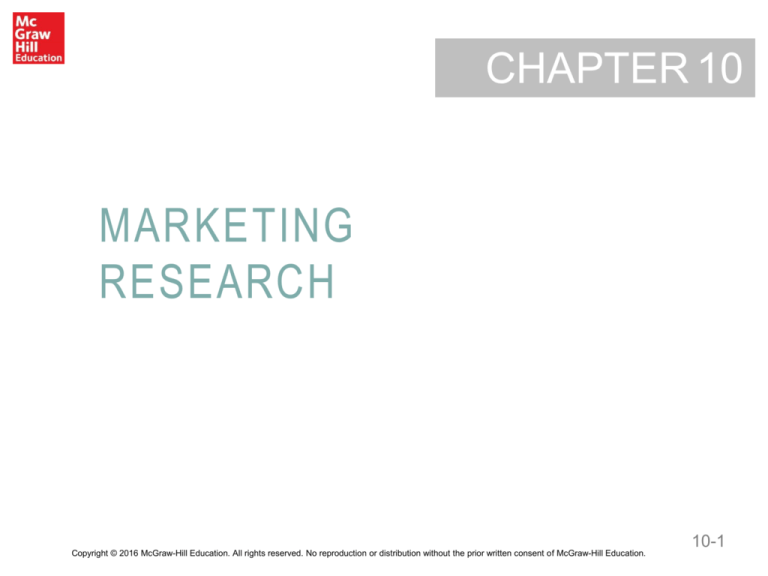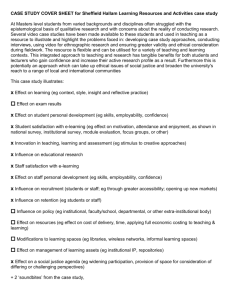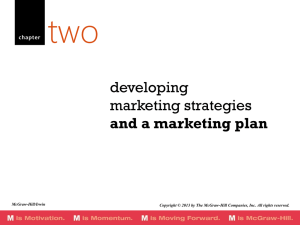
CHAPTER 10
MARKETING
RESEARCH
Copyright © 2016 McGraw-Hill Education. All rights reserved. No reproduction or distribution without the prior written consent of McGraw-Hill Education.
10-1
Marketing Research
LEARNING OBJECTIVES
LO1
Identify the five steps in the marketing research
process.
LO2
Describe the various secondary data sources.
LO3
Describe the various primary data collection
techniques.
LO4
Summarize the differences between secondary
data and primary data.
LO5
Examine the circumstances under which
collecting information on consumers is ethical.
10-2
Disney
Ron S Buskirk/Alamy
10-3
McDonald’s Makeover
10-4
Market Research Outcome
What might have
Chef Boyardee
learned in research to
design this product
and this print ad?
Ad Courtesy of ConAgra Foods
10-5
Marketing Research
Collecting
Recording
Analyzing
Interpreting
Decision
Making
10-6
What Would You Do?
Meet Aaron, a marketing researcher:
•
He has just finished
giving a successful
presentation to a major
client.
•
The client has asked for
a list of companies that
participated in the study
and copies of all the
completed surveys.
Ryan McVay/Getty Images
CASRO
10-7
The Marketing Research Process
Defining the
objectives and
research needs
Designing the
research
Analyzing data
and
developing
insights
Developing and
implementing an
action plan
Collecting the
data
10-8
Step 1: Defining Objectives
and Research Needs
What information is
needed to answer
specific research
questions?
How should that
information be
obtained?
10-9
Step 2: Designing the Research
Type of data
Type of
research
10-10
Step 3: Collecting the Data
10-11
©Getty Images
Step 4: Analyzing Data
and Developing Insights
Converting data into information to explain, predict
and/or evaluate a particular situation.
10-12
Step 5: Developing and
Implementing an Action Plan
Executive Summary
Body
Conclusions
Limitations
Digital Vision/Getty Images
Supplements including
tables, figures, appendices
10-13
CHECK YOURSELF
1. What are the steps in the marketing research
process?
2. What is the difference between data and
information?
10-14
External Secondary Data
Syndicated Data
10-15
Courtesy The Nielsen Co
External Secondary Data
Scanner Research
IRI
10-16
External Secondary Data
Panel Research
Group of consumers
Survey or sales receipts
©BananaStock/PunchStock
What are they
buying
or not buying?
Flying Colours Ltd/Getty Images
10-17
Internal Secondary Data
Data Warehouse
Data Mining
10-18
CHECK YOURSELF
1. What is the difference between internal and
external secondary research?
10-19
Qualitative versus Quantitative
Data Collection Techniques
Qualitative research
Quantitative research
Data
collection
research
10-20
Data Collection
Qualitative Research
Observation
Social Media
In-depth
interview
Focus group
In-Store
Tracking
Analytics
10-21
Describing the benefits
How could Ziploc use
qualitative research to
design this ad?
SC Johnson Co
10-22
CHECK YOURSELF
1. What are the types of qualitative research?
10-23
Survey Research
10-24
Web Surveying
Response rates are
relatively high
Respondents may lie
less
Results are
processed and
received quickly
Simon Fell/Getty Images
It is inexpensive
10-25
Using Web Surveying
The McGraw-Hill Companies, Inc/
John Flournoy, photographer
How do firms successfully use web surveying?
10-26
Experimental Research
AP Photo/Mary Altaffer
10-27
Advantages and Disadvantages of
Secondary and Primary Data
Type
Examples
Advantages
Disadvantages
Secondary
Research
Census data
Sales invoices
Internet information
Books
Journal articles
Syndicated data
Saves time in collecting data
because they are readily
available
Free or inexpensive (except for
syndicated data)
May not be precisely relevant
to information needs
Information may not be timely
Sources may not be original,
and therefore usefulness is an
issue
Methodologies for collecting
data may not be appropriate
Data sources may be biased
Primary
Research
Observed consumer behavior
Focus group interviews
Surveys
Experiments
Specific to the immediate
data needs and topic at hand
Offers behavioral insights
generally not available from
secondary research
Costly
Time consuming
Requires more sophisticated
training and experience to
design
study and collect data
10-28
CHECK YOURSELF
1. What are the types of quantitative research?
2. What are the advantages and disadvantages of
primary and secondary research?
10-29
Debating Domestic Eavesdropping
10-30
The Ethics of
Using Customer Information
Strong ethical
orientation
Adhere to
ethical practices
10-31
CHECK YOURSELF
1. Under what circumstances is it ethical to use
consumer information in marketing research?
2. What challenges do technological advances
pose for the ethics of marketing research?
10-32











